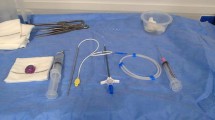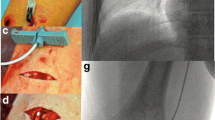Abstract
Purpose: To perform a retrospective outcomes analysis of central venous catheters with peripheral venous access ports, with comparison to published data.
Methods: One hundred and twelve central venous catheters with peripherally placed access ports were placed under sonographic guidance in 109 patients over a 4-year period. Ports were placed for the administration of chemotherapy, hyperalimentation, long-term antibiotic therapy, gammaglobulin therapy, and frequent blood sampling. A vein in the upper arm was accessed in each case and the catheter was passed to the superior vena cava or right atrium. Povidone iodine skin preparation was used in the first 65 port insertions. A combination of Iodophor solution and povidone iodine solution was used in the last 47 port insertions. Forty patients received low-dose (1 mg) warfarin sodium beginning the day after port insertion. Three patients received higher doses of warfarin sodium for preexistent venous thrombosis. Catheter performance and complications were assessed and compared with published data.
Results: Access into the basilic or brachial veins was obtained in all cases. Ports remained functional for a total of 28,936 patient days. The port functioned in 50% of patients until completion of therapy, or the patient’s expiration. Ports were removed prior to completion of therapy in 18% of patients. Eleven patients (9.9% of ports placed) suffered an infectious complication (0.38 per thousand catheter-days)—in nine, at the port implantation site, in two along the catheter. In all 11 instances the port was removed. Port pocket infection in the early postoperative period occurred in three patients (4.7%) receiving a Betadine prep vs two patients (4.2%) receiving a standard O.R. prep. This difference was not statistically significant (p=0.9). Venous thrombosis occurred in three patients (6.8%) receiving warfarin sodium and in two patients (3%) not receiving warfarin sodium. This difference was not statistically significant (p=0.6). Aspiration occlusion occurred in 13 patients (11.7%). Intracatheter urokinase was infused in eight of these patients and successfully restored catheter function in all but two instances. These complication rates are comparable to or better than those reported with chest ports.
Conclusion: Peripheral ports for long-term central venous access placed by interventional radiologists in the interventional radiology suite are as safe and as effective as chest ports.
Similar content being viewed by others
References
Broviac JW, Cole JJ, Scribner BH (1973) A silicone rubber atrial catheter for prolonged parenteral alimentation. Surg Gynecol Obstet 136:602–606
Hickman RO, Buckner CD, Clift RA, Sanders JE, Stewart P, Thomas ED (1979) A modified right atrial catheter for access to the venous system in marrow transplant recipients. Surg Gynecol Obstet 148:871 - 875
Niederhuber JE, Ensminger W, Gyres JW. Liepman M, Doan K, Cozzi E (1982) Totally implanted venous and arterial access systems to replace external catheters in cancer treatment. Surgery 92:706–711
Khoury MD, Lloyd LR, Burrows J, Berg R, Yap J (1985) A totally implanted venous access svstem for the delivery of chemotherapy. Cancer 56:1231–1234
Lokich JL, Bothe A, Benotti P. Moore C (1985) Complications and management of implanted venous access catheters. J Clin Oncol 3:710–717
Brincker H, Saeter G (1986) Fifty-five patient years’ experience with a totally implanted system for intravenous chemotherapy. Cancer 57: 1124–1129
Brothers TE, Von Moll LK, Niederhuber JE, Roberts JA, Walker-Andrews S, Ensminger WD (1988) Experience with subcutaneous infusion ports in three hundred patients. Surs Gynecol Obstet 66:295–301
Mueller BU. Skelton J. Callender DP. Marshall D, Gress J, Longo D. Norton J. Rubin M, Venzon D. Pizzo PA (1992) A prospective randomized trial comparing the infectious and noninfectious complications of an externalized catheter versus a subcutaneously implanted device in cancer patients. J Clin Oncol 10 (12): 1943–1948
Greene FL. Moore W, Strickland G, McFarland J (1988) Comparison of a totally implantable access device for chemotherapy (Port-A-Cath) and long-term percutaneous catheterization (Broviac). South Med J 81 (5): 580–583
Ross MN, Haase GM, Poole MA. Burrington JD, Odom LF (1988). Comparison of totally implanted reservoirs with external catheters as venous access devices in pediatric oncologic patients. Surg Gynecol Obstet 167 (2): 141–144
Ingram J, Weitzman S, Greenberg ML. Parkin P. Filler R (1991) Complications of indwelling venous access lines in the pediatric hematology patient: A prospective comparison of external venous catheters and subcutaneous ports. Am J Pediatr Hematol Oncol 13 (2): 130–136
Beheshti MV, Protzer WR, Tomlinson TL, Martinek E, Baatz LA, Collins MS (1998) Long-term results of radiologic placement of a central vein access device. AJR 170 (3):731–734
Kaufman JA, Salamipour H, Geller SC. Rivitz SM. Waltman AC (1996) Long-term outcome of radiologicallv placed arm ports. Radiology 201 (3):725–730
Prandoni P, Polistena P, Bernardi E, Cogo A, Casara D, Verlato F, Angelini F, Simioni P, Signorini GP, Benedetti L, Girolami A (1997) Upper-extremity deep vein thromhosis: Risk factors, diagnosis, and complications. Arch Int Med 13:157(1):57–62
Salem RR, Ward BA, Ravikumar TS (1993) A new peripherally implanted subcutaneous permanent central venous access device for patients requiring chemotherapy. J Clin Oncol 11:2181–2185
Finney R, Albrink MH. Hart MB. Rosemurgy AS (1992) A cost-effective peripheral venous port system placed at the bedside. J Surg Res 53:17–19
Lundberg G, Wahlberg E, Rickberg A, Olofsson P (1995) PAS-Port: A new implantable vascular access device for arm placement: Experience from the first two years. Eur J Surg 161:323–326
Foley MJ (1995) Radiologic placement of long-term central venous Peripheral Access System Ports (PAS Port): Results in 150 patients. J Vase Interv Radiol 6:255–262
Simpson KR, Hovsepian DM. Picus D (1997) Interventional radiologic placement of chest wall ports: Results and complications in 161 consecutive patients. J Vase Interv Radiol 8:189–195
Pegues D, Axelrod P, McClarren C, Eisenberg BL, Hoffman JP, Ottery FD, Keidan RD, Boraas M. Weese J (1992) Comparison of infections in Hickman and implanted port catheters in adult solid tumor patients. J Surg Oncol 49:156–162
Shetty PC, Mody MK, Kastan DJ. Sharma RP, Burke MW, Venugopal C. Burke TH (1997) Outcome of 350 implanted chest ports by interventional radiologists. J Vase Interv Radiol 8 (6):991–995
Brant-Zawadzki M, Anthony M, Mercer EC (1993) Implantation of a PAS Port venous access device in the forearm under fluoroscopic guidance. AJR 60:1127–1128
Kahn ML, Barboza RB, Kling GA, Heisel JE (1992). Initial experience with percutaneous placement of the PAS Port implantable venous access device. J Vase Interv Radiol 3:459–161
Hills JR. Cardella JF. Cardella K. Waybill PN (1997) Experience with 100 consecutive central venous access ports placed by interventional radiologists. J Vase Interv Radiol 8 (6):983–989
Rubenstein EB, Fender A, Rolston KV, Eking LS, Prasco P. Palmer J. Road I, Pollock RE, Frisbee-Hume S, Laurence D (1995) Vascular access by physician assistants: Evaluation of an implantable peripheral port svstem in cancer patients. J Clin Oncol 13:1513–1519
Linder L, Curelaru I. Gustavsson B, Hansson H, Stenqvist O. Wojciechowski J (1984) Material thrombogenicity in central venous catheterization: Comparison between soft antebrachial catheters of silicone elastomer and polyurethane. J Parent Enteral Nutr 8:399–406
Bern MM. Lokich JJ. Wallach SR. Bothe A Jr, Benotti PN, Arkin CF, Greco FA, Huberman M, Moore C (1990) Very low doses of warfarin can prevent thrombosis in central venous catheters: A randomized prospective trial. Ann Int Med 112:423–428
Puel V, Caudry M. Le Metayer P, Baste JC, Midy D, Marsault C, Demeaux H, Maire JP (1993) Superior vena cava thrombosis related to catheter malposition in cancer chemotherapy given through implanted ports. Cancer 72:2248–2252
Nazarian G, Bjarnason H. Dietz C, Bernadas C, Hunter D (1997) Changes in tunneled catheter tip position when a patient is upright. J Vase Interv Radiol 8:437–441
Kowalski C, Kaufman J, Rivitz S, Geller S, Waltman A (1997) Migration of central venous catheters: Implications for initial catheter tip positioning. J Vase Interv Radiol 8:443–447
Author information
Authors and Affiliations
Rights and permissions
About this article
Cite this article
Bodner, L.J., Nosher, J.L., Patel, K.M. et al. Peripheral venous access ports: Outcomes analysis in 109 patients. Cardiovasc Intervent Radiol 23, 187–193 (2000). https://doi.org/10.1007/s002700010041
Issue Date:
DOI: https://doi.org/10.1007/s002700010041




